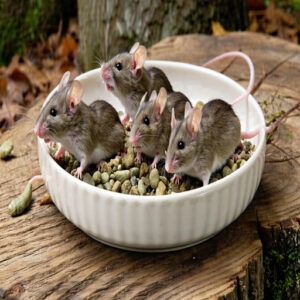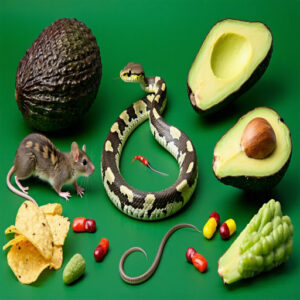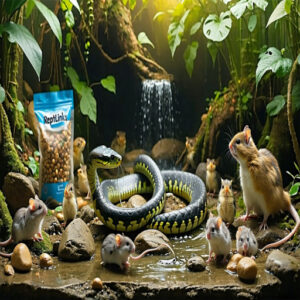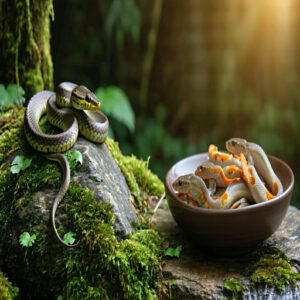This site is supported by our readers. We may earn a commission, at no cost to you, if you purchase through links.

A proper healthy snake nutrition guide includes a diet rich in calcium and phosphorus (in a 2:1 ratio) to support strong bones, along with vitamin D3 for absorption.
Protein-packed whole prey like appropriately sized mice or fish (depending on the species) is a staple.
Don’t forget hydration–clean water and humidity levels are key.
Every species has quirks—some love eggs, others thrive on rodents.
Watch for signs of malnutrition or obesity.
With care, you’ll keep their scales shiny and their appetite happy!
Table Of Contents
- Key Takeaways
- Essential Nutrients for Optimal Snake Health
- Dietary Needs of Different Snake Species
- Safe and Unsafe Foods for Snakes
- Proper Feeding Techniques and Schedules
- Creating a Balanced Snake Diet Plan
- Recognizing and Addressing Nutritional Deficiencies
- Environmental Factors Affecting Snake Nutrition
- Specialized Nutrition for Breeding Snakes
- Monitoring and Maintaining Healthy Snake Nutrition
- Frequently Asked Questions (FAQs)
- What is a healthy snake nutrition guide?
- What is the best diet for a snake?
- Is the snake diet a healthy choice?
- Do snakes need nutritional supplements?
- What is a snake diet plan?
- What do snakes eat?
- What nutrients do snakes need?
- What can snakes not eat?
- What does a snake eat in 30 words?
- How often should snakes be fed?
- Conclusion
Key Takeaways
- Make sure your snake gets whole prey with the right calcium-to-phosphorus ratio (2:1) and enough vitamin D3 for strong bones and healthy shedding.
- Match prey size to your snake’s widest girth, and avoid toxic or harmful foods like avocado and fireflies.
- Provide clean water daily, maintain proper humidity, and use UVB lighting if needed to boost hydration and nutrient absorption.
- Adjust feeding frequency and prey types based on your snake’s species, age, and life stage to meet their unique nutritional needs.
Essential Nutrients for Optimal Snake Health
To keep your snake healthy, you’ve got to provide the right balance of nutrients like calcium, protein, and vitamins.
It’s not as tricky as it sounds—just think of their food as a full-package deal, covering hydration, essential minerals, and everything they need to thrive, including vitamins.
Calcium and Phosphorus Balance
Getting the right calcium-to-phosphorus ratio is like balancing a seesaw—essential for your snake’s bone health.
Stick to a 2:1 or 3:1 ratio, leaning toward more calcium.
Offer calcium-rich prey or sprinkle a little powdered calcium on meals.
Avoid overloading on phosphorus, which can mess with nutrient absorption and lead to calcium deficiency or even bone issues.
Keep it balanced!
Vitamin D3 Importance
Vitamin D3 is like the unsung hero of your snake nutrition guide.
It’s what helps calcium absorption work its magic, keeping their bones strong and shedding smooth.
Snakes missing out on Vitamin D3 might show weak bone health or bad sheds—big red flags!
Want to prevent vitamin D3 deficiency?
- Use UVB lighting for natural vitamin D3 synthesis.
- Watch for signs like shedding problems or bone issues.
- Manage their calcium-phosphorus ratio for ideal results.
It’s a small tweak with huge benefits.
Protein Requirements
Snakes, being carnivores, thrive on protein-rich diets for muscle growth and development.
Proper protein intake, sourced from whole prey like mice or rats, meets their amino acid and nutrient balance needs.
Keep prey size right for your snake’s age and girth—feeding them too big or too small isn’t healthy.
A strong, well-fed snake means better health and fewer surprises, which is the result of a protein-rich diet.
Trace Minerals
Protein’s important, but don’t skip trace minerals—they’re tiny powerhouses behind your snake’s skin, muscles, and even venom.
Think of iron, zinc, and copper as backstage crew keeping your snake thriving.
A proper mineral balance prevents issues like mineral deficiency or toxicity.
Providing prey animals naturally rich in these minerals or using supplements like zinc supplements keeps your snake’s nutritional needs—calcium, phosphorus, vitamin D3, too—on track.
Hydration Needs
Keeping your snake hydrated is easier than it sounds! Just follow these steps:
- Provide clean water daily in a sturdy bowl to guarantee proper fluid intake and digestive health.
- Monitor hydration levels by checking for dehydration signs like wrinkled skin or sunken eye caps.
- Maintain proper humidity levels to support drinking habits and healthy shedding.
Simple tweaks mean happy, hydrated snakes!
Dietary Needs of Different Snake Species
Not all snakes eat the same meals, so it’s important to know your pet’s specific dietary needs.
Whether they prefer rodents, birds, or even eggs, giving them the right prey keeps them healthy and happy.
Carnivorous Nature of Snakes
A snake’s carnivorous nature is its survival masterpiece.
They live fully on a carnivore diet, with hunting strategies that rival top predators.
Whether venomous or constricting, they masterfully capture wild prey, meeting their nutritional needs.
Their diet revolves around fresh food sources—whole prey that fuels proper snake nutrition.
Think of them as nature’s ultimate recyclers, turning meals into energy without wasting a single bite.
Prey Size and Type Selection
Choosing the right prey size is like finding the perfect shoe fit—it shouldn’t be too big or too tight.
Stick to prey matching your snake’s widest body part, and gradually increase size with growth, but don’t overdo it.
Add prey variation with these options:
- Rodents (mice, rats)
- Small birds
- Quail chicks
- Whole prey fish
Meal planning matters!
Feeding Frequency Variations
Feeding schedules aren’t one-size-fits-all—snake feeding cycles depend on age, size, and species.
Younger snakes, like juveniles, eat smaller prey more often, while adults enjoy larger meals less frequently.
A comprehensive snake diet guide offers detailed information on species-specific needs and safe food options.
Prey size matters; match it to your snake’s girth.
Optimize their feeding frequency with careful observation.
Species-specific diets guarantee health.
Stay flexible—it’s a balancing act, not a rigid recipe!
Specialized Diets for Specific Species
Not all snakes eat the same! Species nutrition plans matter more than you’d think.
Constrictors love large meals, garter snakes nibble fish, and arboreal types swoop birds.
Understanding their needs keeps your pet thriving. A proper snake diet considers species, age, and size, as detailed in this comprehensive snake diet guide.
- Constrictors: Large prey like rats.
- Garter snakes: Fish and amphibians.
- Egg-eating snakes: Bird eggs.
- Tree pythons: Birds.
- Venomous species: Small mammals.
Nutritional Adaptations in Wild Vs Captive Snakes
Think of wild snake diets as a buffet—rodents, birds, or even eggs—keeping nutrient uptake natural and balanced.
Captive feeding? It’s more like an all-you-can-eat pasta night: convenient but not always diverse.
Wild prey fuels adaptive eating and snake metabolism, while captive snakes depend on your choices.
Maintaining proper calcium and phosphorus levels is vital, so understanding a healthy snake nutrition guide is essential for responsible pet ownership.
This snake nutrition guide reminds you: matching their nutritional needs is key to ensure a healthy snake.
Safe and Unsafe Foods for Snakes
Feeding your snake the right prey is key to keeping it healthy, but some foods can be downright dangerous.
You wouldn’t want to accidentally serve something harmful, so it’s important to know which options are safe and which to avoid.
Appropriate Prey Animals
Picking the right prey animals is a big deal in your snake nutrition guide.
Always go for whole prey items like mice, rats, or even quail to meet their carnivorous nature. These are nutrient-rich foods that mimic their wild diet.
- Top picks include:
- Mice and rats (perfect for most snakes).
- Quail or chicks for variety.
- Fresh food sources over processed options.
- Prey size matching the widest snake girth.
- Wild-caught alternatives (if safe).
Toxic and Harmful Food Items
Not everything edible is safe for snakes.
A few bites of a bad bait can be deadly.
Avoid toxic foods like:
- Avocado: Loaded with persin, it’s a poisonous fruit for reptiles.
- Fireflies: These harmful insects contain toxic lucibufagins.
- Processed foods: Snakes thrive on whole prey, not snacks.
Stick to whole, fresh prey to dodge toxicology scares!
Risks of Feeding Live Prey
Feeding live prey isn’t just risky—it’s like tossing your snake into a boxing ring.
A cornered mouse could bite back, causing prey injury risk or infections.
Escapees? Another headache.
Plus, snake stress skyrockets during these live prey dangers, and prey-born diseases might tag along.
Stick to safer options for fewer feeding accidents and a healthier playbook in your snake nutrition guide.
Benefits of Frozen-Thawed Prey
Frozen-thawed prey is like meal prep for snakes—convenient, nutritious, and way safer than live prey.
No need to worry about bites or scratches from feisty rodents, keeping your snake safe.
It also saves time and money, thanks to easy storage and handling.
- Snake Safety: No injuries from aggressive prey.
- Prey Handling: Less stress for you.
- Thawing Methods: Simple to prepare.
- Nutrient Retention: Just as good as fresh.
Supplements and Vitamin Additives
A sprinkle of calcium additives or snake vitamin supplements like Rep-Cal can boost nutrient enhancers for your snake.
But don’t go overboard! Too much can turn helpful mineral supplements into trouble.
You can find a variety of snake vitamin supplements online.
Proper vitamin balance prevents issues like vitamin D3 deficiency and vitamin A deficiency, which can harm health.
Stick to recommended doses—your slithery buddy doesn’t need a protein booster, just the right care.
Proper Feeding Techniques and Schedules
Feeding your snake isn’t just about tossing it a mouse and calling it a day—it’s all about proper prey size and timing.
By sticking to the right feeding schedule and techniques, you’ll keep your scaly friend healthy, happy, and hiss-free.
Determining Appropriate Prey Size
Regarding Prey Size Guidelines, think of feeding like picking the right size sweater for your snake.
The prey’s girth should match the snake’s widest point—no overstuffed burritos here.
A proper preytosnake ratio helps avoid choking or digestion problems.
Stick to agespecific prey so your snake can handle it.
A well-fed snake shows a slight bulge but stays sleek and healthy.
Feeding Frequency Based on Age and Species
Young snakes grow fast and need frequent meals.
Hatchling feedings happen every few days to support their rapid Snake Growth Rates.
Adults? They’re more into weekly or biweekly Feeding Schedules.
Age Based Diets depend on Species Nutrition too.
A ball python’s pace differs from a garter snake’s.
Adjust based on snake age, feeding frequency, and their nutritional needs, keeping prey size appropriate for their body.
Handling and Presentation of Food
Serving up a snake’s meal isn’t rocket science, but it’s an art with some must-know tips.
Use food tongs to keep it safe and hygienic—nobody wants a finger mistaken for food!
For specialized tongs and other feeding tools, explore a wide selection of food tongs.
Stick to frozen-thawed prey for safety and health.
Aim for prey that’s girth-friendly—about the same size as your snake’s widest part.
Prey presentation matters:
- Wiggle it to mimic live movement.
- Warm it slightly for realism.
- Avoid handling food directly.
Master these feeding techniques confidently!
Post-feeding Care and Monitoring
Once your snake finishes eating, it’s time for postfeeding care.
Keep an eye out for these:
- A calm snake basking or coiled—you’re seeing digestion at work.
- Warning signs like regurgitation or bloating hinting at digestion issues.
- Clean up after their poop—an indirect check of their health.
Avoid handling for two to three days post-meal; their stomach needs peace to process that mouse.
Snake observation and healthy snake habits go hand in hand for long-term snake health monitoring!
Adjusting Diet for Breeding Snakes
Breeding takes a toll on your snake, so tweaking their menu is essential.
Female snakes need extra calories pre-breeding and calcium during reproduction, while males benefit from slight dietary boosts.
Post-laying, ease females back to regular feeding as they recover.
Here’s a quick guide:
| Stage | Female Needs | Male Needs |
|---|---|---|
| Pre-breeding | High-calorie intake | Slight increase |
| Breeding | More calcium | Regular diet |
| Post-laying | Gradual recovery | Normal feeding |
The breeding process and subsequent recovery require careful management of a snake’s diet to ensure the health and well-being of both the female and male snakes.
Regular monitoring and adjustments to their diet are crucial for a successful breeding outcome.
Creating a Balanced Snake Diet Plan
Creating a balanced snake diet plan means picking the right prey and meeting your snake’s specific nutritional needs.
Don’t worry—it’s easier than it sounds once you understand their natural diet and how to keep things healthy and varied!
Variety in Prey Selection
Your snake deserves more than a monotonous menu!
Mixing up prey types mirrors wild diets and also enhances captivity’s enrichment factor.
Try these for easy prey variety:
- Switch up rodent species (like mice, rats, or gerbils).
- Offer birds such as quail or chicks for occasional treats.
- Explore reptile-friendly blends like ReptiLinks.
Keep an eye on snake preferences—some stick with familiar favorites.
Gradual changes to their prey selection make adjustments smoother and stress-free!
Nutritional Value of Different Prey Types
Switching up prey types isn’t just smart—it’s essential for snake nutrition.
Each prey type brings something different to the table: rodents pack protein and fats, while birds and fish boost nutrient profiles like calcium and omega-3s.
Want to nail your feeding strategies? Focus on dietary diversity with safe prey types to mimic a natural diet.
Always match prey size to your snake’s girth for safe digestion.
Prey variety keeps your snake healthy and thriving, which is why prey variety is so important.
Seasonal Dietary Adjustments
Nature doesn’t stick to one rhythm, and neither should your snake’s meals.
Seasonal dietary adjustments keep your pet healthy and mimic what they’d experience in the wild.
A detailed snake diet guide offers further details on species-specific needs and feeding schedules.
- Fall: Boost portions to prepare them for slower winter feeding.
- Winter: Cut back on meals, since their metabolism slows.
- Spring: Gradually increase prey sizes as their activity picks up.
- Summer: Offer smaller meals more often to match their energy levels.
Seasonal feeding keeps your snake’s nutritional needs balanced, considering temperature effects, humidity control, and nutrient cycling.
Meeting Specific Nutritional Needs
Every snake has its quirks, and meeting their nutritional needs is like tailoring a suit—they need the perfect fit.
A good diet keeps your snake happy and healthy.
Start with whole prey—it’s a complete package of protein, calcium, and fats.
Balance is key, especially the calcium-to-phosphorus ratio, which helps with strong bones.
Add UVB lighting for that Vitamin D3 boost.
| Nutrient | Purpose | Provided By |
|---|---|---|
| Protein | Growth & repair | Prey muscle |
| Calcium | Bone strength | Prey bones |
| Vitamin D3 | Calcium absorption | UVB light & prey |
| Fats | Energy & skin care | Prey body fat |
A balanced snake diet isn’t rocket science but needs attention—feed strategically and monitor their health!
Customizing Diets for Individual Snakes
Figuring out your snake’s dietary needs isn’t a one-size-fits-all deal.
Age, species, and health all play a part in perfecting their meals.
Younger snakes thrive on smaller, frequent feeds, while adults settle for larger prey less often.
Watch their weight and activity like a hawk—adjust as needed.
It’s all about creating a balanced snake diet planning routine that matches their needs.
A well-fed snake? That’s a happy, healthy scaly friend living its best life!
Recognizing and Addressing Nutritional Deficiencies
Your snake’s health can take a hit if it’s not getting the right nutrients, leading to issues like weak bones or poor shedding.
Spotting signs of malnutrition early and making quick dietary changes can keep your scaley friend thriving, which involves understanding the importance of nutrients.
Signs of Malnutrition in Snakes
Wondering if your snake’s diet is on point? Watch for these malnutrition symptoms: unexpected snake weight loss, sluggish behavior, or weak muscles making movement hard.
Skin issues like poor shedding or lesions aren’t just cosmetic—they’re snake health issues screaming for better care.
Here’s what to monitor:
- Visible weight loss or a thin, bony appearance.
- Difficulty shedding or retained skin.
- Abnormal lethargy or reduced activity.
- Dull scales or skin lesions.
Keep their diet balanced!
Common Vitamin and Mineral Deficiencies
Even well-cared-for reptiles can develop nutrient disorders.
Here’s what you need to watch for:
- Thiamine Crisis: Fish-eating snakes often face vitamin B1 deficiency, causing tremors and balance issues
- Calcium-Phosphorus Problems: Poor UV exposure leads to weak bones, despite proper ratios
- Vitamin A Troubles: Impacts eye health and scales, especially in fish-eating species
- Vitamin E Issues: Feeding fatty prey like obese rats can trigger this deficiency
A quick vet check can catch these sneaky nutritional deficiencies before they become serious problems.
Overfeeding and Obesity Issues
Just like humans after too many holiday treats, your snake can pack on extra pounds.
Watch for these weight fluctuations and obesity risks in your scaly friend:
| Warning Sign | Health Impact | Prevention Tips |
|---|---|---|
| Scale Folding | Organ Strain | Monthly Weighing |
| Round Shape | Reduced Mobility | Portion Control |
| Visible Fat Rolls | Shortened Lifespan | Scheduled Meals |
Obesity takes a serious toll on your snake’s health, raising mortality rates by 50%, which is a significant health impact due to weight fluctuations.
Look for wrinkled scales spreading apart – it’s like your snake wearing clothes that are too tight.
Corrective Dietary Measures
Today it’s time for smart dietary corrections to get your scaly friend back on track.
Start with a balanced diet plan that includes gut-loaded prey to boost nutritional value.
Here’s your snake rehabilitation roadmap:
- Track feeding portions at 10-15% of body weight
- Dust prey with calcium powder for proper supplementation
- Add vitamin D3 supplements to support nutrient absorption
- Monitor weekly progress through weight checks
Your success checklist:
- Trust your instincts
- Stay committed
- Watch for improvements
- Share your wins
Veterinary Intervention for Nutritional Problems
Professional veterinary care marks the difference between quick recovery and prolonged snake malnutrition.
Watch for red flags like sudden appetite changes, unusual lethargy, or skin problems – these signal it’s time for an expert checkup.
Your veterinarian will assess nutritional deficiencies through blood work and physical exams, then create a targeted dietary therapy plan.
| Warning Sign | Required Action | Treatment Approach |
|---|---|---|
| Weight Loss | Emergency Intervention | Multivitamin Injections |
| Skin Issues | Immediate Vet Visit | Vitamin C Support |
| Lethargy | Health Assessment | Nutritional Therapy |
| Appetite Loss | Blood Testing | Dietary Adjustments |
| Weakness | Physical Exam | Vitamin Supplementation |
Environmental Factors Affecting Snake Nutrition
You’ll be surprised to learn that your snake’s environment plays a huge role in how well it digests and uses its food, just like how you wouldn’t want to eat your dinner in a freezing cold room.
Your pet’s enclosure temperature, humidity levels, and lighting setup directly affect everything from how quickly it digests its meals to how well it absorbs essential nutrients, making these factors just as important as the food itself.
Temperature and Digestion Relationship
Your snake’s digestion works like a well-tuned heat engine, powered by its environment.
Keep the temperature just right, and you’ll see food digested faster, improving digestive health.
Mess up, though, and things slow down.
- High temps (around 82°F) speed up the digestion process, cranking up metabolic speed.
- Cool temps? Cold impact stalls everything.
- Too cold causes food refusal and an unhappy snake digestion process.
Humidity Impact on Hydration
Humidity levels do more than keep your snake’s skin smooth—they’re key for hydration and digestive health, too.
Without proper moisture balance, snakes struggle with shedding or even breathing.
Water quality matters, so always provide clean water alongside good humidity control.
Here’s a quick rundown:
| Species | Ideal Humidity | Low Humidity Issues | High Humidity Issues |
|---|---|---|---|
| Royal Python | 60-80% | Bad shedding | Scale rot risk |
| Corn Snake | 40-60% | Dehydration | Respiratory issues |
| Sand Boa | 20-30% | Usually fine | Skin infections |
Even desert snakes need a humid hide for hydration!
Lighting and Vitamin D3 Synthesis
Don’t overlook lighting in relation to your snake’s health.
While they mightn’t need UVB lighting as much as other reptiles, it still boosts vitamin D3 synthesis.
This helps with calcium absorption and maintaining a healthy calcium-phosphorus ratio—vital for strong bones and smooth snake shedding.
Here’s how UVB helps:
- Low-intensity UVB supports natural activity and vision.
- It mimics sunlight, aiding vitamin D production.
- Some species thrive with D3 supplements and proper UVB exposure.
Stress Factors Influencing Appetite
Sometimes your snake’s appetite disappears, and stress might be the troublemaker.
Environmental stress can mess with their eating patterns, causing feeding refusal or appetite loss.
Here are common stress factors in their world:
- Loud noises or constant disruptions.
- Lack of secure hiding spots.
- Nearby pets like cats or dogs, triggering snake anxiety.
A stress-free environment means happy, hungry snakes.
Manage these issues, and your snake’s nutrition guide will thank you!
Seasonal Changes and Feeding Behavior
Seasonal feeding isn’t just about food—it’s about understanding your snake’s natural rhythm.
In spring, males might skip meals during breeding cycles, while summer sees a steady snake feeding schedule.
Fall’s cooler temps trigger pre-hibernation prep, so increase portions for added energy.
Winter often slows appetite due to cold weather, mimicking snake migration patterns in the wild.
Each snake is unique, so watch for changes in prey preferences or nutritional needs.
Seasonal dietary adjustments keep your scaly buddy healthy year-round!
Dehydration and Kidney Problems
A thirsty snake isn’t just grumpy—it’s at risk for dehydration and even kidney failure.
Watch for dehydration signs like sunken eyes, saggy skin, or sluggish behavior.
For a detailed guide to recognizing dehydration, review these telltale dehydration symptoms.
Always provide clean water, as poor water quality can lead to kidney problems and trouble shedding.
Some snakes won’t sip from bowls, so mist their enclosure or use a soaking dish.
Keeping humidity balanced is key for hydration and overall snake health.
Nutritional Impact on Shedding and Skin Health
Your snake’s nutrition directly impacts shedding and skin health.
A balanced diet prevents shedding issues and skin lesions.
Think of it as a beauty regimen from the inside out.
- Calcium balance supports strong scales and healthy shedding cycles.
- Proper humidity control prevents stuck shed and promotes supple skin.
- Nutrient deficiencies can lead to dull scales and skin lesions.
Consult your vet about your healthy snake’s snake nutrition.
Specialized Nutrition for Breeding Snakes
When your snake is preparing to breed, its diet needs a little extra attention to meet higher energy and calcium demands.
Proper nutrition during breeding guarantees healthy eggs, strong hatchlings, and a smooth recovery for the mother.
Pre-breeding Dietary Adjustments
Before breeding, tweak your snake’s dietary needs with a few key adjustments.
Gradually bump up meal sizes to help build proper weight—think of it as strength training for breeding.
Add female supplements like calcium to support egg nutrition and maintain a balanced diet plan.
Throw in dietary shifts with varied prey to mimic life in the wild.
With the right pre lay diet, your snake will handle this phase like a pro, minus the gym membership!
Nutritional Support During Gestation
Pregnancy nutrition for gravid females can feel tricky, especially when appetite vanishes near parturition.
Don’t stress—this is normal for many species, like the aspic viper, which often fasts during gestation.
Instead of pushing large meals, stick to offering smaller prey weekly.
If she skips a meal, let her be; it’s all part of reproductive care.
Focus on a gestation diet rich in calcium to support fetal development.
A healthy snake needs patience and smart dietary choices during this sensitive time.
Post-laying Nutritional Recovery
Post-laying care is all about helping your snake recharge after the exhausting work of laying eggs.
Think of it as her recovery meal plan!
- Feed smaller, frequent meals with calcium-rich prey to support her healing and bone strength.
- Keep her hydrated with fresh water available at all times.
- Monitor her weight—she may only nibble at first, and that’s okay!
- Stay patient—your healthy snake will regain her appetite as her energy returns.
Nutrient replenishment is key to her breeding health!
Feeding Gravid Females
Caring for gravid females takes some planning.
Stick to smaller meals served a bit more often to keep your girl healthy while supporting her developing eggs.
Calcium-rich foods are a must—think of it as her “pregnancy craving.”
Some snakes might keep eating, others may skip meals entirely, and that’s okay.
Always monitor her weight and energy levels.
Adjust as needed because every snake’s different, and pregnant snake care isn’t an exact science, but attentive feeding guarantees reproductive health.
Nutritional Considerations for Hatchlings
Baby snakes, or hatchlings, need a specialized diet to thrive. Focus on their nutrient needs and faster growth rates.
Here’s a quick snake nutrition guide:
- Offer pinky mice, rat pups, or similar-sized prey.
- Feed juvenile snakes more often than adults.
- Watch their growth and adjust portion sizes.
- Avoid nutritional deficiencies by sticking to species-specific plans.
Happy hatchling, healthy snake!
Monitoring and Maintaining Healthy Snake Nutrition
Keeping your snake healthy means tracking its weight, diet, and overall condition regularly. It’s like being your pet’s personal health coach, only with fewer push-ups and more mice.
Regular Weight Checks and Body Condition Scoring
Think of weight monitoring as your snake’s wellness report card.
Regular weight checks with a kitchen scale and gentle body scoring can help your pet’s health stay on track.
For specialized needs, consider a snake weight scale.
A healthy snake should feel firm, not squishy, with a smooth, upside-down U-shaped back.
Sudden weight fluctuations? It might be time to adjust care—consistent health tracking makes all the difference, ensuring your snake’s overall health stays optimal.
Fecal Examination for Nutritional Assessment
Ever thought poop could clue you into snake health? A fecal examination isn’t just gross—it’s essential!
- Check stool quality for undigested bits signaling nutrient deficiency.
- Spot digestive issues like parasites in fecal analysis.
- Color changes? They reveal shifts in snake nutrition.
- Consistency matters! Hard or loose stools flag digestive system concerns.
Your snake’s stool is a secret health tracker!
Blood Work for Nutritional Imbalances
Think of blood work as your snake’s health report card.
It reveals nutritional deficiencies, like low calcium or vitamin imbalances, with precision.
Vets use serum analysis as a diagnostic tool to check health markers, spotting hidden problems.
It’s like solving a mystery—your vet’s the detective, armed with syringes to maintain your snake’s nutrient levels at the highest standard for exceptional health.
Regular monitoring for snake nutritional deficiencies is essential to prevent serious health issues in pets.
Adjusting Diets as Snakes Age
Aging snake nutrition isn’t one-size-fits-all.
As your snake grows, adjust its diet to match lower energy needs and slower growth rates.
Senior snake care means tweaking prey size, feeding frequency, and nutrition to prevent age-related deficiencies or obesity.
Here’s a quick guide:
- Feed smaller prey that matches your snake’s girth.
- Space out feedings for older snakes.
- Watch for signs of dietary shifts affecting snake health.
Record Keeping for Long-term Nutritional Management
Think of feeding logs as your snake’s health diary.
Tracking meals, skipped feedings, and weight changes helps you spot dietary trends and adjust for peak snake health.
With proper record keeping, you’ll catch issues early—like overeating or deficiencies, and nutrient tracking and data analysis are your secret weapons for long-term wellness.
It’s a simple step in mastering nutritional management and ensuring your snake thrives!
Frequently Asked Questions (FAQs)
What is a healthy snake nutrition guide?
Picture a balanced scale—your snake’s health depends on the right mix of whole prey, hydration, and species-specific care.
Stick to proper prey sizes, skip risky foods, and provide fresh water and UVB lighting.
What is the best diet for a snake?
You want your pet snake to thrive, not just survive.
Their diet should replicate what they’d eat in the wild: whole animal prey, with the right calcium, phosphorus, and vitamin D3 ratios.
Is the snake diet a healthy choice?
Jumping on the snake diet trend?
Sure, it’s protein-packed, but it’s far from a balanced plan for humans.
Snakes thrive on whole prey, not smoothies.
Stick with their feeding habits—not their menu—for health inspo.
Do snakes need nutritional supplements?
You don’t need to worry about supplements if your snake eats whole prey like mice or rats.
These provide everything needed, which is a complete concept for the nutritional needs of snakes.
But, a vet might suggest calcium or Vitamin D3 for specific conditions or breeding females.
What is a snake diet plan?
Feeding a snake is like crafting a custom menu—match prey size to their girth, stick with whole prey like mice or rats, and adjust frequency based on age, species, and activity.
This approach should keep it simple.
What do snakes eat?
Your slithery friend thrives on whole prey like mice, rats, or quail, depending on the species.
Some munch insects or eggs.
Always match prey size to the snake’s girth—no oversized meals for these picky eaters!
What nutrients do snakes need?
Your slithery pal thrives on a balanced mix of proteins, fats, and essential nutrients like calcium, phosphorus, and vitamin D3.
Trace minerals and hydration seal the deal for health, growth, and vibrant shedding.
What can snakes not eat?
You know what they say, "One bad apple spoils the bunch."
Avoid feeding snakes avocado, fireflies, processed foods, or dairy—these are toxic or harmful.
Stick to whole prey like mice, rats, or birds instead.
What does a snake eat in 30 words?
Your scaly buddy thrives on whole prey like mice, rats, quail, or even fish for some species.
Keep portions sized to their thickest body part—no avocado or fireflies though, those spell trouble!
How often should snakes be fed?
How often you feed your snake depends on its size, age, and species.
Younger snakes chow down twice a week, while adults eat less often—around every one to two weeks.
Pay attention to their behavior!
Conclusion
You know what they say, "An ounce of prevention is worth a pound of cure."
Keeping your snake happy and healthy starts with a steady, balanced diet using this healthy snake nutrition guide.
From proper prey size to hydration and vitamin needs, every detail matters.
Pay attention to your snake’s species, monitor their appetite and weight, and don’t skimp on variety or routine checks.
With care and consistency, your slithery friend will thrive for years, following a balanced diet.
- https://vcahospitals.com/know-your-pet/snakes-feeding
- https://serpentsuppers.com/snake-feeding-chart/
- https://www.msdvetmanual.com/management-and-nutrition/nutrition-exotic-and-zoo-animals/nutrition-in-snakes
- https://www.petplace.com/article/reptiles/general/feeding-your-snake
- https://medium.com//what-do-snakes-eat-a-comprehensive-guide-to-snake-diets-c13bd017c8b6























